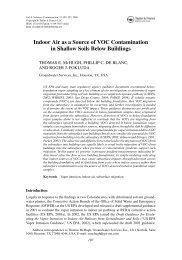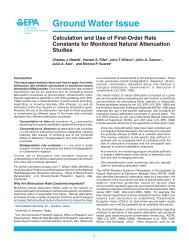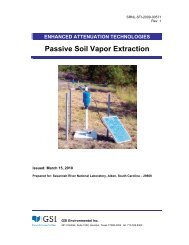direct hydrogen addition for the in-situ biodegradation of chlorinated
direct hydrogen addition for the in-situ biodegradation of chlorinated
direct hydrogen addition for the in-situ biodegradation of chlorinated
You also want an ePaper? Increase the reach of your titles
YUMPU automatically turns print PDFs into web optimized ePapers that Google loves.
Groundwater Services, Inc. Nov. 1997<br />
Fe + 2H + → Fe 2+ + H 2<br />
Conceptually, <strong>hydrogen</strong> delivery via an <strong>in</strong>-<strong>situ</strong> controlled release reaction would<br />
<strong>in</strong>volve <strong>the</strong> placement <strong>of</strong> a <strong>hydrogen</strong> releas<strong>in</strong>g cartridge with<strong>in</strong> a well or borehole<br />
that would operate <strong>in</strong> a passive mode (Figure 2). When us<strong>in</strong>g metals, <strong>the</strong> cartridge<br />
would consist <strong>of</strong> metal fil<strong>in</strong>gs mixed with a carrier matrix (e.g., sand) and conta<strong>in</strong>ed<br />
with<strong>in</strong> a permeable sack. Groundwater pass<strong>in</strong>g through <strong>the</strong> well would <strong>the</strong>n contact<br />
<strong>the</strong> cartridge, caus<strong>in</strong>g <strong>the</strong> release <strong>of</strong> <strong>hydrogen</strong>. The rate <strong>of</strong> <strong>hydrogen</strong> release would<br />
be controlled by <strong>the</strong> pH <strong>of</strong> <strong>the</strong> groundwater <strong>in</strong> contact with <strong>the</strong> cartridge. This, <strong>in</strong><br />
turn, could be controlled by <strong>the</strong> release <strong>of</strong> an acid solution with<strong>in</strong> <strong>the</strong> same, or<br />
upgradient wells. When <strong>the</strong> ability <strong>of</strong> <strong>the</strong> cartridge to release <strong>hydrogen</strong> has been<br />
depleted, <strong>the</strong> cartridges may be removed and replaced with fresh units.<br />
As an alternate method, any type <strong>of</strong> <strong>hydrogen</strong> releas<strong>in</strong>g material could be mixed<br />
with sand or gravel and placed <strong>direct</strong>ly with<strong>in</strong> a trench or excavation to <strong>in</strong>tercept<br />
mov<strong>in</strong>g groundwater <strong>in</strong> a funnel-and-gate type application.<br />
These types <strong>of</strong> delivery systems are best suited to plume management applications where<br />
<strong>the</strong> goal is to create a barrier to <strong>the</strong> growth <strong>of</strong> dissolved constituent plumes, but could also<br />
be applied to source reduction. The primary advantage <strong>of</strong> <strong>the</strong>se types <strong>of</strong> systems is that<br />
<strong>the</strong>y do not require <strong>the</strong> pump<strong>in</strong>g or handl<strong>in</strong>g <strong>of</strong> groundwater.<br />
Well cas<strong>in</strong>g<br />
Hydrogen releas<strong>in</strong>g<br />
cartridge<br />
Hydrogen enriched<br />
groundwater<br />
Low pH<br />
groundwater<br />
Figure 2. Concept <strong>of</strong> Hydrogen Releas<strong>in</strong>g Cartridge.<br />
6






